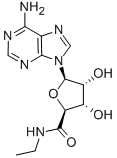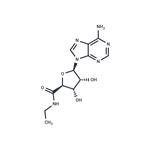
NECA
- Product NameNECA
- CAS35920-39-9
- CBNumberCB0763077
- MFC12H16N6O4
- MW308.29
- MDL NumberMFCD00069195
- MOL File35920-39-9.mol
- MSDS FileSDS
Chemical Properties
| Melting point | 229-231°C |
| Density | 1.87±0.1 g/cm3(Predicted) |
| storage temp. | 2-8°C |
| solubility | 45% (w/v) aq 2-hydroxypropyl-β-cyclodextrin: 0.2 mg/mL Solutions may be stored for several days at 4°C. |
| pka | 12.93±0.70(Predicted) |
| form | powder |
| color | white |
| Water Solubility | 45% (w/v) aq 2-hydroxypropyl-β-cyclodextrin: 0.2mg/mL (Solutions may be stored for several days at 4 °C.) DMSO: 14mg/mL (Solutions may be stored for several days at 4 °C.) 0.1 M HCl: 3.4mg/mL (Solutions may be stored for several days at 4 °C.) H2O: insoluble ethanol: soluble (Solutions may be stored for several days at 4 °C.) |
| Stability | Hygroscopic |
| InChIKey | JADDQZYHOWSFJD-FLNNQWSLSA-N |
| CAS DataBase Reference | 35920-39-9 |
| UNSPSC Code | 12352200 |
| NACRES | NA.77 |
Safety
| Symbol(GHS) |

|
| Signal word | Danger |
| Hazard statements | H300 |
| Precautionary statements | P264-P270-P301+P310-P405-P501 |
| Hazard Codes | T+ |
| Risk Statements | 28 |
| Safety Statements | 22-26-36-45 |
| RIDADR | UN 2811 6.1/PG 2 |
| WGK Germany | 3 |
| RTECS | VJ2232000 |
| HazardClass | 6.1(a) |
| PackingGroup | I |
| HS Code | 29349990 |

